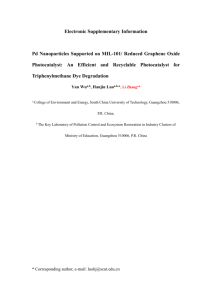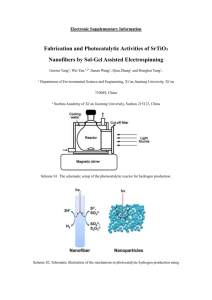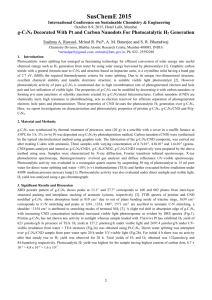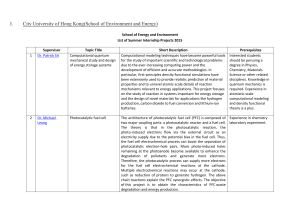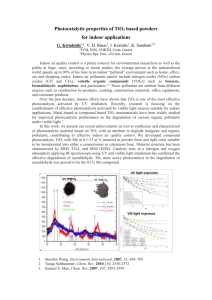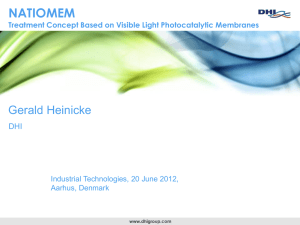This supporting information contains the following sections
advertisement
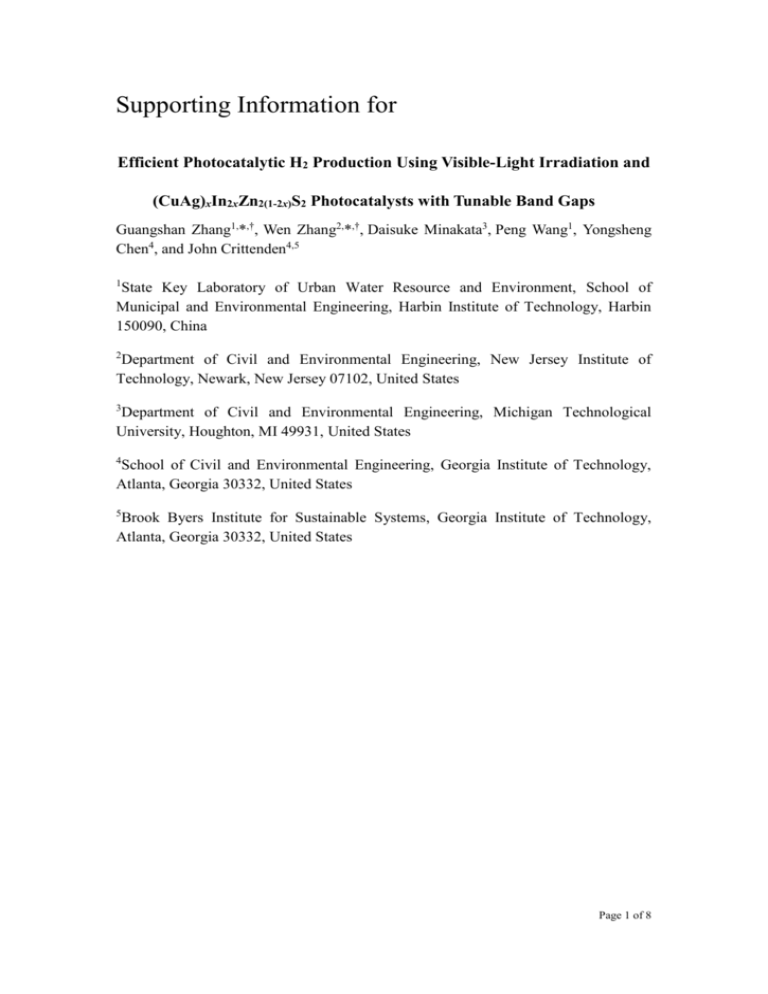
Supporting Information for Efficient Photocatalytic H2 Production Using Visible-Light Irradiation and (CuAg)xIn2xZn2(1-2x)S2 Photocatalysts with Tunable Band Gaps Guangshan Zhang1,*,†, Wen Zhang2,*,†, Daisuke Minakata3, Peng Wang1, Yongsheng Chen4, and John Crittenden4,5 1 State Key Laboratory of Urban Water Resource and Environment, School of Municipal and Environmental Engineering, Harbin Institute of Technology, Harbin 150090, China Department of Civil and Environmental Engineering, New Jersey Institute of Technology, Newark, New Jersey 07102, United States 2 3 Department of Civil and Environmental Engineering, Michigan Technological University, Houghton, MI 49931, United States 4 School of Civil and Environmental Engineering, Georgia Institute of Technology, Atlanta, Georgia 30332, United States 5 Brook Byers Institute for Sustainable Systems, Georgia Institute of Technology, Atlanta, Georgia 30332, United States Page 1 of 8 This supporting information contains the following sections: S1. The bench-scale water-splitting reactor S2. Calculating process for the conduction band and valence band potentials S3. Optimization of photocatalytic reaction conditions Page 2 of 8 S1. The bench-scale water-splitting reactor 300-W Xe lamp 780-mL gas-closed stainless steel reactor water bath N2 inlet Magnetic stirrer and heater Figure S1. A photograph of the bench-scale system with the major components such as the 780-mL gas-closed stainless steel reactor. 300 W Xe lamp Cutoff filter Black cylinder 2 1 H2O N2 Magnetic stirrer Teflon tube (sampling) 4 3 water circulation system Catalyst N2 H2 Reaction solution #1–#4 indicate four air valves This graph is not drawn to scale Hydrogen storage tank Figure S2. The overall schematic design of the H2 generation system. Page 3 of 8 S2. Calculating process for the conduction band and valence band potentials Table S1. Values of the electron affinity, ionization energy and element electronegativity. Constituent Electron affinity Ionization energy Element electronegativity elements (eV) (eV) (eV) Cu 1.235 7.726 4.48 Ag 1.302 7.576 4.44 In 0.30 5.786 3.04 Zn -0.87 9.394 4.26 S 2.077 10.36 6.22 Table S2. X, Eg, ECB, and EVB at the point of zero charge for (CuAg)xIn2xZn2(1-2x)S2. Value of x X (eV) Eg (eV) ECB (eV) EVB (eV) 3.47 0 5.15 -1.09 2.38 2.72 0.025 5.13 -0.73 1.99 2.36 0.05 5.11 -0.57 1.79 0.1 5.07 2.12 -0.49 1.63 1.93 0.15 5.04 -0.43 1.50 1.78 0.25 4.96 -0.43 1.35 1.62 0.3 4.93 -0.38 1.24 0.5 4.79 1.51 -0.47 1.04 Table S3. PZZP, conduction and valence band edge energies for (CuAg)xIn2xZn2(1-2x)S2 at pH 2.0 with respect to NHE. Value of x 0 0.025 0.05 0.1 0.15 0.25 0.3 0.5 PZZP ECB (eV) EVB (eV) 1.7 -1.11 2.36 3.1 -0.67 2.05 3.4 -0.49 1.87 4.2 -0.36 1.76 4.0 -0.31 1.62 4.2 -0.30 1.48 4.7 -0.22 1.40 6.8 -0.19 1.32 Page 4 of 8 S3. Optimization of photocatalytic reaction conditions From the above analysis, (CuAg)0.15In0.3Zn1.4S2 was chosen as the model photocatalyst that presumably has the highest visible light photocatalytic activity for the following experiments, which systematically evaluated the reaction parameters and pinpoint the optimal photocatalytic conditions for H2 production. In particular, the optimal initial pH for the photocatalytic H2 production has been analyzed in our previous work [1], which indicated that the lower the initial pH is, the faster the H2 production rate could be obtained. Thus, in this study, a constant initial solution pH of 2.0 was employed without the further investigation. S3.1. Effect of the Ru loading amount on H2 production rate Figure S3 shows the influence of the Ru loading amount on photocatalytic H2 production. Without any Ru addition, the H2 production was zero, indicative of the important role of Ru as the cocatalyst in this photocatalytic process [2]. The photocatalytic activity increased significantly with the increasing Ru loading and reached the maximum level of 230 µmol m−2 h−1 at a Ru loading dose of 0.7 wt% in the suspension, which compares well with previous reports [3-5]. In a previous study, additional increases in the Ru loading dose did not enhance the H2 production rate but inhibited photocatalytic H2 production [3]. This is probably because the number of catalytic active sites on the (CuAg)0.15In0.3Zn1.4S2 interface increases with the increasing Ru loading to some extent and thus increases the photocatalytic activity [4]. However, the excessive deposition of Ru on the photocatalyst surface will negatively affect light absorption and thus H2 production [3]. In the following tests, 0.7 wt% was selected as the optimal dose of Ru. (a) (b) Figure S3. (a) H2 production as a function of irradiation time and (b) photocatalytic H2 production rates per Ru loading amount on the (CuAg)0.15In0.3Zn1.4S2 photocatalyst. S3.2. Effect of the initial KI concentration on H2 production rate Figure S4 shows the H2 production rate at different initial KI concentrations. The H2 production rate gradually increased as the KI concentration increased from 0 to 0.2 Page 5 of 8 M. However, further increasing the KI concentration from 0.2 to 0.25 M did not change the H2 production rate. Similar results were observed when methanol [6,7], HPr [8], and glucose [9] were used as electron donors. Because the surface adsorption of I− follows the Langmuir isotherm equation [8,9], at high KI concentrations, the H2 production rate leveled off, which indicates that the photocatalyst surface may be saturated with I− and no longer provide available reaction sites for photocatalytic H2 evolution. The photocatalytic H2 production rate varies as a function of KI concentration, which is reported to follow the Langmuir-Hinshelwood-Hougen-Watson kinetic model [10,11]: r dnH2 dt k ' K [I- ] 1 K [I- ] (1) where r represents the H2 production rate, µmol m−2 h−1; k' represents the maximum specific H2 production rate when the I− concentration reaches infinity, µmol m−2 h−1; and K represents the adsorption constant of KI on the photocatalyst surface, L mol−1. We fitted the experimental H2 production rate data with this Langmuir isotherm equation. The best fit was achieved by minimizing the Objective Function (OF), which is defined as below [12]: 1 N rexp,i rcal ,i N 1 i 1 rexp,i 2 OF (2) where rexp,i and rcal,i are the experimental and calculated H2 production rates for a particular KI concentration (i) at a certain reaction time, respectively, and N is the number of data points. As shown in Figure S4, the OF was 0.069, indicating that the model fit (the dashed line) was within ± 0.069 of the experimental data for 68% of the fitted values, assuming that the difference follows a normal distribution and the OF is the sample deviation. The fitting results show that k' and K are 301 µmol m−2 h−1 and 15.8 L mol−1, respectively. Page 6 of 8 Figure S4. Effect of initial KI concentration on photocatalytic H2 production over the Ru/(CuAg)0.15In0.3Zn1.4S2 photocatalyst. S3.3. Effect of the photocatalyst dose on H2 production rate Figure S5 shows the effect of photocatalyst dose on the H2 production rate. As expected, the optimal photocatalyst dose with the greatest apparent H2 production rate was approximately 1.0 g L−1. Further increases in the photocatalyst dose decreased the photocatalytic H2 production dramatically, because the high concentration of photocatalyst interfered with light transmission or penetration into the suspension according to the Beer-Lambert law [13,14], which was verified in our previous paper [15]. Consequently, the photocatalytic reactor underwent a significant loss of incident light energy penetration [4]. Figure S5. Effect of the photocatalyst dose on photocatalytic H2 production over the Ru/(CuAg)0.15In0.3Zn1.4S2 photocatalyst. S3.4. Effect of the reaction temperature on H2 production rate Figure S6 shows the photocatalytic H2 production rate at various temperatures ranging from 25C to 55C. The H2 production rate slightly increased with the increase in temperature, from 230 µmol m−2 h−1 at 25C to 249 µmol m−2 h−1 at 55C. The temperature dependence of the H2 production rate is consistent with previous results [16,17] and obeys the Arrhenius equation over the range of 25−55C. Page 7 of 8 Figure S6. H2 production rate over the Ru/(CuAg)0.15In0.3Zn1.4S2 photocatalyst at different reaction temperatures. When the other reaction conditions were fixed, the H2 production rate for the Ru/(CuAg)0.15In0.3Zn1.4S2 photocatalyst, considering reaction temperature, can be expressed as: E r = k0 exp(- A ) (3) R T where r is the H2 production rate (µmol cm−2 h−1), k0 is the reaction constant (µmol cm−2 h−1), EA is the activation energy of the reaction (kJ mol−1), R is the universal gas constant (8.31 × 10−3 kJ mol−1 K−1) and T is the reaction temperature (K). Figure S7 shows an Arrhenius plot of the photocatalytic H2 production rate. The activation energy was estimated a approximately 2.3 kJ mol−1 from the Arrhenius plot, indicating that an elevated reaction temperature would be favorable for H2 production. Considering the energy consumption, because the photocatalytic activity of the photocatalyst increased only 8.3% from 25C to 55C, the room temperature (25C) is used as reaction temperature. Figure S7. Arrhenius plot of the photocatalytic H2 production rate. REFERENCES: 1. Zhang GS, Zhang W, Minakata D, Chen YS, Crittenden J, Wang P. The pH effects on H2 evolution kinetics for visible light water splitting over the Page 8 of 8 Ru/(CuAg)0.15In0.3Zn1.4S2 photocatalyst. International Journal of Hydrogen Energy 2013; 38: 11727-11736. 2. Linsebigler AL, Lu GQ, Yates JT. Photocatalysis on TiO2 surfaces: principles, mechanisms, and selected results. Chemical Reviews 1995; 95: 735-758. 3. Wang DH, Wang L, Xu AW. Room-temperature synthesis of Zn0.80Cd0.20S solid solution with a high visible-light photocatalytic activity for hydrogen evolution. Nanoscale 2012; 4: 2046-2053. 4. Bao NZ, Shen LM, Takata T, Domen K. Self-templated synthesis of nanoporous CdS nanostructures for highly efficient photocatalytic hydrogen production under visible. Chemistry of Materials 2008; 20: 110-117. 5. Tsuji I, Kato H, Kudo A. Visible-light-induced H2 evolution from an aqueous solution containing sulfide and sulfite over a ZnS-CuInS2-AgInS2 solid-solution photocatalyst. Angewandte Chemie International Edition 2005; 44: 3565-3568. 6. Higashi M, Abe R, Takata T, Domen K. Photocatalytic overall water splitting under visible light using ATaO2N (A = Ca, Sr, Ba) and WO3 in a IO3−/I− shuttle redox mediated system. Chemistry of Materials 2009; 21: 1543-1549. 7. Al-Mazroai LS, Bowker M, Davies P, Dickinson A, Greaves J, James D, Millard L. The photocatalytic reforming of methanol. Catalysis Today 2007; 122: 46-50. 8. Wei LF, Zheng XJ, Zhang ZH, Wei YJ, Xie B, Wei MB, Sun XL. A systematic study of photocatalytic H2 production from propionic acid solution over Pt/TiO2 photocatalyst. International Journal of Energy Research 2012; 36: 75-86. 9. Fu XL, Long JL, Wang XX, Leung DYC, Ding ZX, Wu L, Zhang ZZ, Li ZH, Fu XZ. Photocatalytic reforming of biomass: A systematic study of hydrogen evolution from glucose solution. International Journal of Hydrogen Energy 2008; 33: 6484-6491. 10. Li YX, Zhang K, Peng SQ, Lu GX, Li SB. Photocatalytic hydrogen generation in the presence of ethanolamines over Pt/ZnIn2S4 under visible light irradiation. Journal of Molecular Catalysis A: Chemical 2012; 363: 354-361. 11. Li YX, Me YZ, Peng SQ, Lu GX, Li SB. Photocatalytic hydrogen generation in the presence of chloroacetic acids over Pt/TiO2. Chemosphere 2006; 63: 1312-1318. 12. Zhang W, Rittmann B, Chen YS. Size effects on adsorption of hematite nanoparticles on E. coli cells. Environmental Science & Technology 2011; 45: 2172-2178. 13. Wang X, Shih K, Li XY. Photocatalytic hydrogen generation from water under visible light using core/shell nano-catalysts. Water Science and Technology 2010; 61: 2303-2308. 14. Crittenden J, Trussell RR, Hand DW, Howe KJ, Tchobanoglous G. Water Treatment: Principles and Design. 3rd ed. New Jersey: Wiley; 2012. 15. Zhang GS, Zhang W, Wang P, Minakata D, Chen YS, Crittenden J. Stability of an H2-producing photocatalyst (Ru/(CuAg)0.15In0.3Zn1.4S2) in aqueous solution under visible light irradiation. International Journal of Hydrogen Energy 2013; 38: 1286-1296. Page 9 of 8 16. Suzuki E, Hayashi Y, Shimomura Y, Yoshida S, Usami H, Nakasa A, Fujimatsu H. Kinetics study on photocatalytic hydrogen generation from hydrogen sulfide. Journal of Chemical Engineering of Japan 2005; 38: 824-827. 17. Yossan S, O-Thong S, Prasertsan P. Effect of initial pH, nutrients and temperature on hydrogen production from palm oil mill effluent using thermotolerant consortia and corresponding microbial communities. International Journal of Hydrogen Energy 2012; 37: 13806-13814. Page 10 of 8

